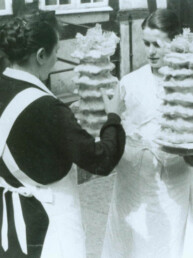
Baumkuchen
(Layered cake)
Freshly baked Baumkuchen is simply the most delicious pastry in the world. It is best served with a cup of tea or coffee. In the Salzwedel of today, three independent Baumkuchen bakeries are incorporated. They export to countries all over the world. They offer guided tours and even Baumkuchen baking clinics upon request.
www.baumkuchen-salzwedel.de, info@baumkuchen-salzwedel.de, 03901–32306, St.-Georg-Straße 87, 29410 Salzwedel, Mrs. Hennig. She made the photo illustrations availabe for publication on this website.
www.salzwedelerbaumkuchen.de, kontakt@salzwedelerbaumkuchen.de, 03931-699049, Tuchmacherstraße 59, 29410 Salzwedel, Mr. Bosse. Filiale in der Kl. St.-Ilsenstraße near the foundation office.
www.baumkuchen-saw.de, info@baumkuchen-saw.de, 03901-34094, Salzwedeler Baumkuchen GmbH, Am Güterbahnhof 19, 29410 Salzwedel, Mrs. Lehmann, Mrs. Bachert.
Production Baumkuchen is made from a stirred dow, the so-called mass, which is shoveled onto a spinning shaft with a soup ladle. The shaft is warmed from the side by radiation emanating from a flame or a heated surface. The shaft is rotated by an electric motor. The cylinder surface of the shaft is made of hard wood, onto which parchment paper (grease-proof paper) is spanned. The radiation adds a thin, baked layer of dow every time the shaft rotates. Surplus mass drops into an elongated pan underneath the shaft. This mass is mixed with fresh mass and repeatedly shoveled onto the rotating shaft. The characteristic undulating landscape of the Baumkuchen cylinder is owed to the viscosity and plasticity of the mass, which draws additional mass from above before the unbaked dow drops into the pan underneath. After cooling to room temperature, Baumkuchen is coated with either a sugar or a chocolate coating.
Baumkuchen are baked with open fire. Some bakeries employ electricity, gas or coal.
What is unique about Baumkuchen from Salzwedel? To be designated “Salzwedeler Baumkuchen”, four criteria must be fulfilled: (i) The Baumkuchen must be baked in Salzwedel, (ii) the mass must be manually applied with a ladle, (iii) a rotating shaft must be employed, (iv) combs to smoothen the cake’s cylinder are prohibited. Every sold piece is unique in space and time. A recipe for the mass is not mandated. Nevertheless, in 1807 Schernikow jotted down a standard recipe for reference.
When were Baumkuchen from Salzwedel first mentioned? The doctor (Hofmedicus) of the court of the Great Principal of Prussia (Großer Kurfürst), Johann Sigismund Elsholz, mentioned Baumkuchen for the first time in 1682 in a document, which is stored in the historic archive of a Berlin bakery. The document is entitled “Gewürztes Brot und von allerhand Gebackenes” (Spiced bread and various other baked goods). It describes a particular Berlin pastry, a large cake, which was named “Placentae cylindricae” or “Baumkuchen” (literally: tree cake). Source: Dr. Franz Lederer, Berliner Lokalanzeiger Nr. 575 vom Sonntag d. 4.12.1932, 1. Beiblatt.
How did Baumkuchen make it to Salzwedel? In the 18th century Ernst August Garves served the Prussian prince Markgraf von Schwedt as kitchen master. He moved on to Salzwedel and took on running the tavern Neustädter Keller. His second daughter Christiane Charlotte Elisabeth married the musician Johann Joachim Friedrich Lentz in 1801. In 1820 Lentz bought the Neustädter Keller from the city. After her husband passed away, Madame Lentz took over running the tavern together with her daughter Louise. Louise stumbled upon the cook book her grandfather had written and learned the art of Baumkuchen making. When king Friedrich Wilhelm IV visited Salzwedel on May 26th, 1841, the city gave a dinner in his honor. The king liked the served Baumkuchen so much, he asked kindly to be allowed to take a portion home for his wife.
How did Baumkuchen conquer the world? For Christmas 1841, Louise Lentz sent a Baumkuchen to the court in Berlin. In return she received a porcellain collection from the Meißner Porzellan foundry. Soon orders from Vienna and St. Petersburg followed. Baumkuchen had made it to the intenational stage. In Salzwedel, Andreas Fritz Schernikow, a baker’s son, had learned the art of Baumkuchen baking. When king Wilhelm I spent November 22nd, 1865, in Salzwedel, Schernikow delivered an ornate Baumuchen to the dinner in the Propstei (today Danneil Museum). Schernikow was designated Supplier to the Royal Court ever after. F. Schernikow passed away in 1875. His nephew Fritz Gerecke took over his bakery. Another nephew, the son of A.F. Schernikow’s brother Karl, Emil Schernikow, founded a bakery for Baumkuchen and ordinary cakes at the corner of Gr. St. Ilsenstraße and Schulwall. For the royal hunt in Letzlingen in 1878, Emil delivered a richly ornamented layered cake. Emperor Wilhelm forthwith designated him as Supplier to the Royal Court. Emil and his baker master Deeling made layered cake from Salzwedel world famous.
Text: E. Reihlen. Sources: Hansestadt Salzwedel, Manfred Lüders, Salzwedel




